EPHESUS ARCHAEOLOGICAL SITE
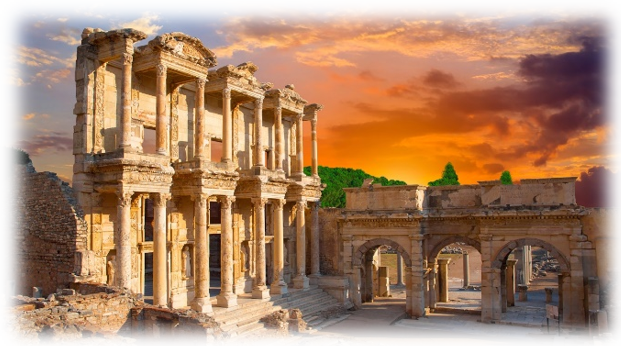 The ancient city of Ephesus is one of Turkey's top s tourist attractions, the most important ancient city, the best preserved and restored. It is an outstanding universal value of the world for all time, and its history dates back to 6000 BC.
The ancient city of Ephesus is one of Turkey's top s tourist attractions, the most important ancient city, the best preserved and restored. It is an outstanding universal value of the world for all time, and its history dates back to 6000 BC.
Ephesus Ancient City consists of temples, theatres, libraries, houses and statues.
The impressive Library of Celsus, the 24.000 capacity grand theatre, the Temple of Hadrian, the Temple of Artemis which is one of the Seven Wonders of the ancient world, the Terrace Houses of Roman nobles and the Cave of Seven Sleepers, the parliament building, commercial and state agoras, baths, city gates, monuments, fountains, public toilets and even a brothel are among the most magnificent archaeological sites in Ephesus.
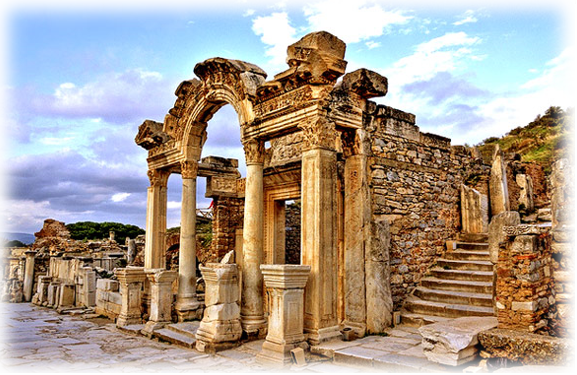 Ephesus, which is one of the Seven Holly Churches mentioned in the Bible, particularly important for faith tourism.
Ephesus, which is one of the Seven Holly Churches mentioned in the Bible, particularly important for faith tourism.
Ephesus was inscribed on the UNESCO World Heritage List in 2015. As one of the most important centres of the ancient era, Ephesus has been inhabited approximately for 9000 years throughout the Hellenistic Era, Roman Period, Byzantine Era, the Period of Principalities and the Ottoman Era.
It was a very prestigious port city and centre of culture and commerce, also one of the most important cities of the Antique Ionia.
The whole site comprises Cukurici Mound, Ayasuluk Hill (Selcuk Fortress, Saint John Basilica built in the 6th century, Isa Bey Mosque which is a sample of Seljuk architecture, Isa Bey Bath, Temple of Artemis), House of the Virgin Mary, and of course Ephesus Ancient City.
HOUSE OF VIRGIN MARY
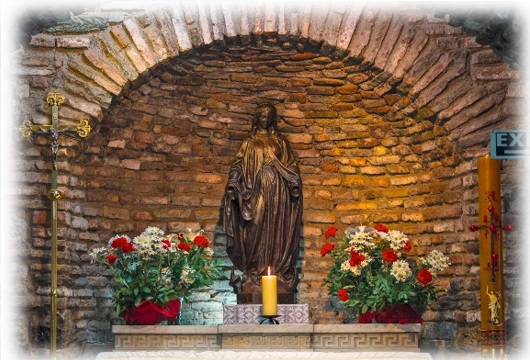 This house, where the Virgin Mary is supposed to have lived during her last days, is situated 7 km south of the antique city of Ephesus in İzmir. The German Nun Katharina Emmerich (1774-1824) described the surroundings of the house from a dream she had. Lazarist monks in İzmir set out in 1891 to find the house based on sister Emmerich's description. They found the remains and built a chapel here. Pope John XXIII declared it a pilgrimage site in 1961.
This house, where the Virgin Mary is supposed to have lived during her last days, is situated 7 km south of the antique city of Ephesus in İzmir. The German Nun Katharina Emmerich (1774-1824) described the surroundings of the house from a dream she had. Lazarist monks in İzmir set out in 1891 to find the house based on sister Emmerich's description. They found the remains and built a chapel here. Pope John XXIII declared it a pilgrimage site in 1961.
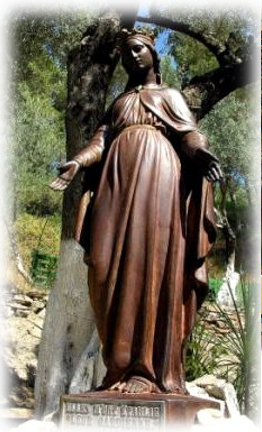 The house of Virgin Mary is a typical Roman architectural example, entirely made of stones. In the 4th century AD, a church, combining her house and grave, has been built. The original two-stored house, which consisted of an anteroom (where today candles are proposed), bedroom and praying room (Christian church area) and a room with fireplace (chapel for Muslims). A front kitchen fell into ruins and has been restored in 1940's. Today, only the central part and a room on the right of the altar are open to visitors. From there one can understand that this building looks more like a church than a house. Another interesting place is the "Water of Mary", a source to be found at the exit of the church area and where a rather salt water, with curative properties, can be drunk by all.
The house of Virgin Mary is a typical Roman architectural example, entirely made of stones. In the 4th century AD, a church, combining her house and grave, has been built. The original two-stored house, which consisted of an anteroom (where today candles are proposed), bedroom and praying room (Christian church area) and a room with fireplace (chapel for Muslims). A front kitchen fell into ruins and has been restored in 1940's. Today, only the central part and a room on the right of the altar are open to visitors. From there one can understand that this building looks more like a church than a house. Another interesting place is the "Water of Mary", a source to be found at the exit of the church area and where a rather salt water, with curative properties, can be drunk by all.
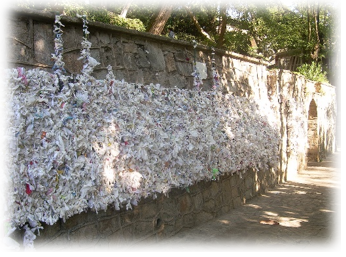 Outside the shrine is a particular "wishing wall" which pilgrims have used by tying their personal intentions on paper or fabric. Various types of florals and fruits are grown nearby, and additional lighting has been installed within the vicinity of the shrine for further monitoring of the site. A water fountain or well is also located nearby, believed by some pilgrims to have miraculous powers of healing or fertility.
Outside the shrine is a particular "wishing wall" which pilgrims have used by tying their personal intentions on paper or fabric. Various types of florals and fruits are grown nearby, and additional lighting has been installed within the vicinity of the shrine for further monitoring of the site. A water fountain or well is also located nearby, believed by some pilgrims to have miraculous powers of healing or fertility.
SIRINCE VILLAGE
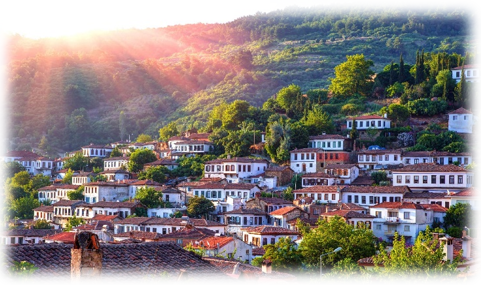
The village lies across a hill about 12 km from the ancient city of Ephesus, 85 km away from Izmir proper. The architecture is truly special and a few houses have been opened to the public to give the public the opportunity to admire it up close and to get a sense of the architectural history of the village. Any new building is required to align with the aesthetic of the village, which is under preservation. Its location on a hill and 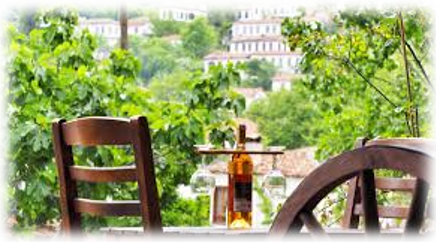 its fertile fields have made it a haven for vineyards, olive orchards and amazing peaches, figs, apples, walnuts and more. When you visit Şirince, you will find wines made from apples, raspberries, blackberries, strawberries, peaches, melons, watermelons, cherries and many other sorts of fruits. Şirince is a charming and cute village, like its name suggests. Şirin is the Turkish word for ‘cute’.
its fertile fields have made it a haven for vineyards, olive orchards and amazing peaches, figs, apples, walnuts and more. When you visit Şirince, you will find wines made from apples, raspberries, blackberries, strawberries, peaches, melons, watermelons, cherries and many other sorts of fruits. Şirince is a charming and cute village, like its name suggests. Şirin is the Turkish word for ‘cute’.
In fact, Şirince is well known mostly since 2012 when the whole world was shaken with rumours about the rupture of the apocalypse on December 21st in 2012. According to the Mayan calendar, this date was the date of the end of the world. A group of people claimed that only Şirince Village and Bugarach Village in Francewould be saved from the apocalypse. According to these rumours, the planet Marduk would hit the world on December 21, 2012 and start the apocalypse. The only people who would survive, would be the ones that were able to board Noah’s Ark, that was going to rise up on the Maden Mountain in Şirince. All of this of course remained to be a rumour and the apocalypse did not come. But the nice result of it all was that Şirince got the attention from the world.
Internet Sources:
https://www.goturkeytourism.com/things-to-do/ephesus-ancient-city-izmir-turkey.html
https://www.ktb.gov.tr/EN-113810/house-of-virgin-mary.html
https://www.ephesus.us/ephesus/houseofvirginmary.htm
https://www.wikizeroo.org/index.php?q=aHR0cHM6Ly9lbi53aWtpcGVkaWEub3JnL3dpa2kvSG91c2Vfb2ZfdGhlX1Zpcmdpbl9NYXJ5
https://www.goturkey.com/en/blog/a-day-in-the-quaint-village-of-sirince
https://kusadasilive.com/near-by-attractions-en/sirince-village-en